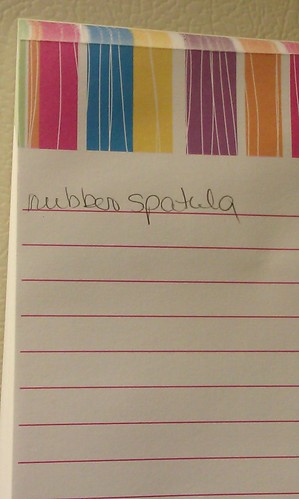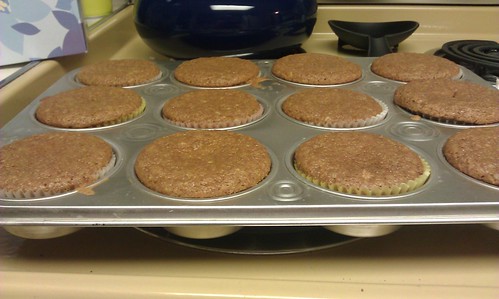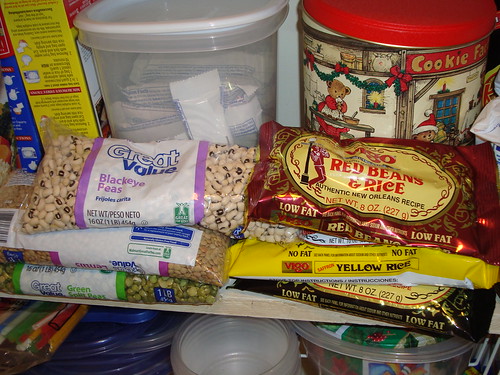They tasted (and still taste) lovely, but I didn't get them right.
I read--and immediately forgot--florafloraflora's note about thoroughly scrubbing the orange. The recipe calls for a whole orange. I used a whole, peeled orange. I've been back and checked my bag of oranges and it has a note about the pesticide and food-grade wax--very tiny print--so it's just as well I peeled the orange. (And you'd expect a warning on the recipe about the need to scrub the orange.) I've written up the recipe to have it handy in the kitchen (rather than on the laptop), and I've added a note about scrubbing the orange in the future.
I pre-heated the oven to 375F. Because the last time I used it (a year ago?) to heat a frozen pizza the pizza cooked in the expected time, I didn't check the oven thermometer. That will come back to bite me.
I got the wet ingredients (sans orange peel) blended in my old Oster; I used oil rather than butter. I got the dry ingredients mixed in a large bowl. I started folding the wet into the dry and things fell apart. Literally.

My trusty rubber spatula broke. I retrieved the pieces from the bowl and reassembled them on the counter to be certain they were all there. I tossed the pieces in the trash and immediately made a note on my shopping list. I did the rest of my stirring with a spoon. Deenbat, I saw your note about making sure my new spatula is rated for high temperatures. Will do.
I added the wet ingredients to the dry slowly, but I seemed to have an awful lot of wet stuff. Is that simply because of the lack of orange peel? Because my results didn't look anything like her photo (on this blog--down just before the raisins); mine looked like a pourable cake batter.
And I discovered that my old blender container leaks at the bottom, where you screw the glass onto the spiky part. I'm pretty sure I had it tightened properly, so I may need to get a new rubber gasket. (A new gasket after 30 years doesn't seem unreasonable.)
So I dribbled my "batter" into paper liners in my old muffin tin. (I used to use the tin to sort tiny items--beads or buttons or stamps.)
You know how bad things go in threes? Spatula broken, blender leaking. It's time for number 3.
I opened the oven and popped the muffin tin in quickly, then closed the door right away to keep the heat from escaping. I set my timer for 15 minutes. Since I was moving quickly, I didn't stop to check the oven thermometer. I got the door closed without the red light coming back on to indicate the oven needed to reheat.
I washed my dishes, and resisted the urge to peek in the oven. Fifteen minutes later, timer went off, and I opened the door to slightly risen batter. Another five minutes on the timer didn't help.

I took the muffin tin out and got a good look at the thermometer. Under 300. (Where the thermometer hangs in the oven--it's hanging from the top rack, dead center--you can't really see the temperature while there's a pan in the oven. Is there a better location? I've always been reluctant to hang it at the front of the oven or over to the side because then it doesn't reflect the temperature where you're actually cooking.) I let the tin sit on top of the stove while I reset the temperature. I finally wound up with the dial set at nearly 450, and the thermometer crept up to 375. I put the tin back in for another five minutes. When I took it out, I didn't have tall, fluffy muffins, but they at least were cooked through (knife came out clean). They're very moist and taste wonderful. They just aren't right.

I'll take another stab at the recipe, probably later this week. (I've still got oranges.) I might try butter rather than oil this time. I'll make sure the temperature is right, which might help the muffins get taller. But any ideas why my batter was so wet? Any other recommendations for this recipe?
Question: When a recipe calls for brown sugar, do you usually get dark brown? Or light? I got dark, but I might try Demerara on my next attempt at this recipe. (I love the sound of that name: Demerara. In Mrs Miniver, isn't that what the air warden cum grocer--Mr Foley--is trying to sell the family in the basement during the first black out? --That, and Italian sardines?) Anyway, I bought some Demerara recently to have as an alternative to white sugar for sweetening.
Question: Are there guidelines for choosing which oil you use in a recipe? I used Vigo extra virgin olive oil since that's what I have, but now I'm seeing bad on-line reviews for it. (Vigo makes most of the beans-and-rice packages I've bought, and of course they recommend their own oil. Maybe I should use it on savory but not sweet dishes?) It's not as if anyone sells something labeled "cooking oil". Also--I do have coconut oil. (I bought it for the dogs--it's good for them--but I always forget I have it.) But maybe I should use butter?

Question: And when a recipe calls for butter, do they mean salted? Unsalted? Or does it matter?
Question: Why do the makers of kitchen canisters not make a canister that will hold a 5-pound sack of flour? I have a full canister--and a left-over half-bag.


5 comments:
Here are a few thoughts...
If it says butter, use butter (not oil). You're impacting flavor and texture, and possibly even the chemistry of the thing.
For butter, I use salted. I also always use a brand I trust, not the store brand. The reason for this is that I have had store brand impact the texture of my baked goods in the past. That's just me - I'm sure others will disagree.
In the old days, we really had (and used) "cooking oil." It was vegetable oil and while you can still get it, your foodie and health conscious friends will run shrieking to take it away from you. You could try going with canola - the problem with coconut or olive for baking is that you're going to impact the taste. I actually keep a small bottle of vegetable oil for certain recipes. I only get the smallest bottle because I rarely use it up before I have to throw it out (it really will get rancid - you'd know from the smell.)
On brown sugar: I buy light granulated. The reason is that the regular (not granulated) will solidify - think "brick" - and wile every baker has a trick they favor for coping with the brick, it's a right pain in the behind no matter how you cope with it. Granulated solves that problem and is a good choice if you think you won't use it often. I've never baked with Demerara, so someone else will have to comment on that.
Given your climate, I'm also going to suggest that you find a way to put any grain product in the fridge for storage. There's nothing more revolting than opening the flour and finding crawling things in it. You can probably wing it for autumn & winter, but by spring you'll want to address this.
My guess as to the wetness of the batter (and it's only a guess) is the substitution of oil for butter. While butter functions in this recipe as a "liquid," and would be liquefied in the blender, it isn't as viscous as oil.
I'm glad they tasted good - that's what matters.
I generally keep vegetable oil for baking sweet things and olive oil for savory things. Mainly because I can taste the olive oil flavor in things I make.
On the brown sugar I use light. I got dark one time by mistake and it's much too strong on the molasses flavor for my liking. I was finally glad to use it up. I don't use a lot of it so I buy a small box and put the contents in a glass or plastic container and keep it in the fridge. This keeps it from turning into the brick that Deenbat talked about!
I don't use butter any more but when I did I used salted in any recipe that called for it. Though some baking and pie crust purists will faint if you suggest such a thing...
The recipe calls for oil or butter and suggests melting the butter so I don't think that was the issue on the thinness of your batter. That happens sometimes. If it does, you can add more flour in small amounts. Maybe a tablespoon at first to see how it shapes up. It doesn't take much to make it thick. You can also over blend things. You could try blending a little less time next time.
I agree about keeping grain products stored in the fridge. The freezer is even better if you have one sitting around. Before my chest freezer broke I kept EVERYthing in there. It made good storage! And you never have lumps in your sugars that way (unless you take it out of the freezer, let it get room temp, put it back in over and over and over.)
Do you know anyone who drinks mass quantities of coffee? Five pound coffee cans are great for storage. Not so pretty but they work. My parents drink it like water so I'm always loaded up with the red plastic Folger's cans. Perfect for a five pound bag of rice, or flour, or other bulk items. I use the one pound cans for beans.
Blogger has been rude and dumped comments from friends. With their permission, I'm copying their comments on Facebook over here so I'll have the answers/comments in one place. From Jessica T:
hmm. i just left a long comment answering your questions but i think it wentt poof. let me know if it doesn't show up! the short answers are: light or brown doesn't matter much. unsalted. canola. large tupperware.
And after I told Jessica T that Blogger ate her longer post, she put this in on Facebook:
here's a longer version then . those muffins look delicious, even if they weren't exactly "right". they remind me of my Dad's favorite birthday cake which also calls for a whole orange (Orange Kissimmee/Kiss Me Cake). you might try looking for organic oranges, which might be a little safer on the pesticide front? the kind of oranges probably matters too here - navels have a very thick skin with a lot of pith; i think valencias are a little thinner skinned. try both and see which you like better.
the only difference between light and dark brown sugar is the amount of molasses. unless the brown sugar is the star ingredient, it won't make a huge flavor difference. demerara sugar just has less molasses than light brown and would probably work fine too. i usually use light but it's really whichever i happen to grab first in the store. always measure brown sugar tightly packed in the cup.
baking recipes always mean unsalted butter, unless otherwise specified, but if all you have on hand is salted, just reduce or eliminate the salt in the recipe. baking is science, so you do want to measure things pretty precisely but i haven't found that a touch of salt either way has thrown things off so much that a recipe fails. cooking is a lot more forgiving of substitutions and experimenting than baking is. in the end, as with knitting, what really matters is whether you like the final product.
as far as oil, you want as neutral a flavor as you can get. olive oil will certainly work fine, but since part of the draw of EVOO is the flavor i save that for savory dishes (like your beans and rice) where it will enhance rather than detract from other flavors in the recipe. i don't have any experience baking with coconut oil, so i'm not sure how that translates. it's rare that a recipe will say butter or oil - they have different properties and purposes in baking. if the recipe calls for oil or butter or shortening or lard, you really want to stick with what's called for. don't melt the butter first unless the recipe says to, but you usually want slightly softened butter rather than straight from the fridge. in some cases you can switch out the solid fats, but they are not one to one equivalents so you'd want to look up the conversion. if a recipe calls for oil, sometimes you can substitute applesauce or mashed banana for a healthier alternative. but if it says something like "cream butter and sugar" you really want to use butter. i don't believe margarine is ever an acceptable substitute for real butter, but that is personal taste and it probably works fine...
i've had the same trouble finding canisters lately. i have some vintage ones that i use at home but i resorted to a large tupperware-type container for flour at my boyfriend's home. i found it at target and it is labeled as able to hold a 5 lb bag of flour, but it doesn't quite. i think the canister in your photo is actually meant for long pasta - at least that's what I use my tall skinny one for. you might be better served by one that is large enough to put a whole cup scoop (and your hand) in. store your leftover flour in the freezer in double ziplocks and it will stay good longer. this is especially true for non-white-AP flours like whole wheat (unless of course you're going through it really quickly).
Blogger dumped Angela Van Tassel's comment, too, so this is what she said on Facebook:
Couldn't post my comment on the blog from the Kindle. Going off Jessica's lead: unsalted, safflower, soak your unpeeled orange in vinegar for several minutes and then scrub before grating because there's nothing better than freshly grated citrus peel. Butter instead of oil unless the recipe specifically states oil -- like for cornbread. I prefer dark brown rather than light, but that's a matter of taste rather than necessity.
Sorry I didn't check in earlier! Your muffins seem to have turned out fine. Seeing your questions makes me realize how much I learned without realizing it from my mother, the food chemistry major. But your attention to detail is a good thing, and if you have a thermometer in your oven you're way ahead of me.
I've mostly lost my sweet tooth (the normal candy bars that other people love taste horribly sweet to me) and I've always been a fan of orange marmalade, so it may be that the normal orangey bitterness that tastes good to me would be yucky to someone else. Or it may be that the wax on the orange peels is too much of a hassle to deal with. I almost always use an organic orange for this recipe.
I've made these muffins more often with oil than butter, and they've been fine every time. You can do that in muffins because they generally call for liquid shortening--a solid shortening makes a firmer, cakier texture. If the recipe calls for cold or "softened" butter you have to use butter, and not spreadable margarine either--that doesn't have enough saturated fat. But in muffins, oil is fine. I'm guessing that the runniness of the batter this time has to do with the absence of the orange peel.
I use olive oil mostly for savory dishes. I have seen recipes for orange cakes made with olive oil, but generally for sweet baking I would use canola or grapeseed. Any oil should be refrigerated to keep it from going rancid--that's not good for flavor or your health. Coconut oil is great for baking. Lots of people use it as a substitute for butter.
Unsalted butter is often fresher than salted, because salt can mask stale flavors, but you can use either. Just adjust the amount of salt you add to the recipe to compensate.
Sugar: I usually use unrefined for regular sugar, so I'm used to a little molasses flavor, and I tend to go darker with brown sugar. But if the recipe doesn't specify you can use light or dark, whatever sounds good to you. The brown sugar tends not to solidify if you keep it really airtight, but just to be safe I add a piece of bread to the package. I don't know why, but that keeps the sugar from hardening.
Your guess on the canisters is as good as mine. I've given up on using them. I just leave flour, sugar, and cornmeal in their bags.
Post a Comment